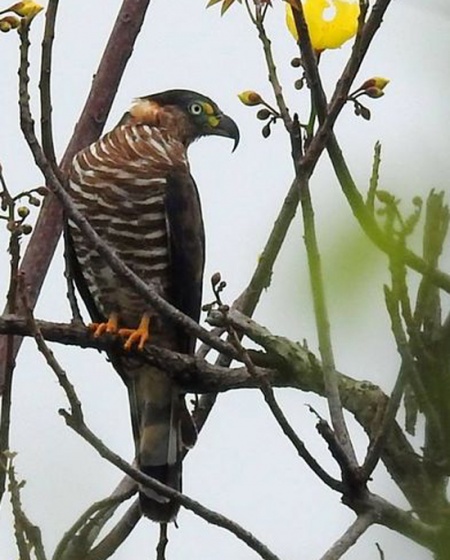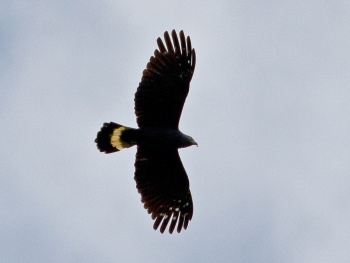Includes Cuban Kite and Grenada Kite
- Chondrohierax uncinatus
Identification
39–51 cm (15¼-20 in)
Light and dark morphs and confusing intermediates. One constant is paddle-shaped wings with transluscent, barred primaries and narrowing near the body.
Distribution
North, Central and South America.
In North America breeds only in extreme southern Texas along the Rio Grande between Falcon Dam and the Santa Ana National Wildlife Refuge. Breeds throughout Mexico and south to Panama and in South America from Colombia and Venezuela to western Peru, Bolivia, Brazil and northern Argentina. Also breeds in the Caribbean in Grenada and Trinidad.
Resident.
Taxonomy
Subspecies
There are two subspecies[1]:
- C. u. uncinatus:
- C. u. uncinatus mirus: Grenada Kite:
Both of these last two subspecies are considered to be full species by some authors[3], [4] and both are critically endangered.
Two additional subspecies: aquilonis and megarhynchus are generally considered invalid[2].
Habitat
Prefers the lower canopy in tropical rainforest and cloud forest, secondary-growth and riverine woodlands, swamps and savannas.
Behaviour
Perches high in trees and can be difficult to see. Not a shy bird.
Diet
Their main diet consists of snails; Cuban birds are also known to eat slugs.
References
- Clements, J. F., T. S. Schulenberg, M. J. Iliff, T. A. Fredericks, J. A. Gerbracht, D. Lepage, S. M. Billerman, B. L. Sullivan, and C. L. Wood. 2022. The eBird/Clements checklist of Birds of the World: v2022. Downloaded from https://www.birds.cornell.edu/clementschecklist/download/
- Gill, F, D Donsker, and P Rasmussen (Eds). 2022. IOC World Bird List (v 12.2) DRAFT. Doi 10.14344/IOC.ML.12.2. http://www.worldbirdnames.org/
- Avibase
- Bierregaard, R.O., Jr, Kirwan, G.M. & Marks, J.S. (2019). Hook-billed Kite (Chondrohierax uncinatus). In: del Hoyo, J., Elliott, A., Sargatal, J., Christie, D.A. & de Juana, E. (eds.). Handbook of the Birds of the World Alive. Lynx Edicions, Barcelona. (retrieved from https://www.hbw.com/node/52955 on 26 July 2019).
- Global Raptor Information Network. 2019. Species account: Hook-billed Kite Chondrohierax uncinatus. Downloaded from http://www.globalraptors.org on 26 Jul. 2019
- Hook-billed Kite (Chondrohierax uncinatus), In Neotropical Birds Online (T. S. Schulenberg, Editor). Cornell Lab of Ornithology, Ithaca, NY, USA. retrieved from Neotropical Birds Online: https://neotropical.birds.cornell.edu/Species-Account/nb/species/hobkit
- Johnson, J.A., Thorstrom, R. & Mindell, D.P. (2007) Systematics and conservation of the Hook-billed Kite including the island taxa from Cuba and Grenada. Anim. Conserv. 10(3): 349-359.
Recommended Citation
- BirdForum Opus contributors. (2025) Hook-billed Kite. In: BirdForum, the forum for wild birds and birding. Retrieved 27 April 2025 from https://www.birdforum.net/opus/Hook-billed_Kite
External Links
GSearch checked for 2020 platform.







